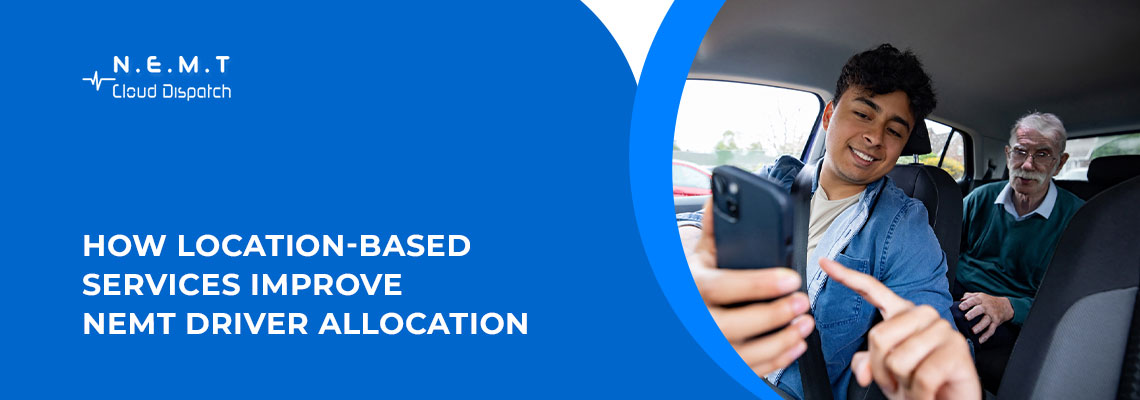In the non-emergency medical transportation industry, efficient and timely transportation is crucial. Patients rely on these services for appointments, treatments, and other healthcare visits. These patients often need specialized vehicles and assistance. One of the biggest challenges in the NEMT industry is efficient driver allocation, which means assigning the right driver to the right patient at the right time.
Understanding Location-Based Services
Location-based services are digital tools that use real-time location data from GPS systems, mobile devices, or others to offer location-aware services. In NEMT services, these services allow transportation providers to:
- Track location driver: See where each driver is at a given time.
- Automate dispatching: Automate match is available, enabling drivers to receive incoming rides.
- Improved communication: Send real-time notifications to patients about driver arrival times.
Benefits of Location-Based Services for NEMT
Location-based services (LBS) use real-time GPS and mapping data to track vehicles, monitor driver location, and optimize routes—this helps make driver allocation easier and more effective. Let’s explore how location-based services improve NEMT driver allocation, benefiting both patients and service providers.
Real-Time Tracking for Accurate Driver Location
Knowing where each driver is at any moment allows dispatchers to allocate drivers based on real-time data. Dispatchers can see exact locations instead of relying on rough estimates or manual communication with drivers. This visibility is beneficial when there is a need for sudden transportation or a last-moment schedule exchange. In such situations, the closest driver would automatically be assigned.
Automated Driver Assignment
Location-based services allow for automated driver allocation, where software automatically matches drivers with passengers based on proximity and availability.
Automate driver assignment benefits providers with faster response time, reduced errors, and the ability to scale operations with minimal additional resources.
Route Optimization to Reduce Delays
Location-based services use route optimization tools to select the route based on real-time traffic conditions, distance, and estimated arrival time. This technology can help reduce delays, as drivers are always directed along the fastest or most efficient route. It helps patients with shorter wait times and on-time arrival for appointments, which is especially critical for patients with time-sensitive medical needs.
There are several benefits of route optimization that you can explore here to “Top 10 Benefits of Route Optimization for Businesses” and see why you need a good route optimization software “Reasons Why Your NEMT Business Benefits from Route Optimization and Planning Software”.
Improved Efficiency and Reduced Costs
With LBS, companies can manage their fleet more efficiently, reducing operational costs. Fuel consumption is minimized, which can translate into significant cost savings over time. Additionally, better allocation of drivers means more trips can be completed in a day. This benefits providers by cost saving from reduced fuel consumption and increased productivity by handling more trips with the same number of vehicles.
Enhanced Patient Experience
Patients can receive real-time updates on driver location, estimated arrival time, and any delays. This feature increases transparency and reduces anxiety for patients who rely on NEMT services, as they know when their driver will arrive. So patients can make the necessary preparations.
Challenges Addressed by LBS in NEMT Driver Allocation
Last-Minute Changes
Last-minute change is expected in NEMT, whether due to a patient’s cancellation or unexpected schedule changes. Location-based services allow dispatchers to quickly reassign drivers or find an alternate solution to reassign the trip.
Geographical Distribution of Trips
In areas where patients are spread out over large areas, it can be challenging to match the right driver with the patient. With location-based tracking, dispatchers can efficiently allocate trips to drivers on who is closest—ensuring that even rural areas or areas where patients receive timely service are covered.
Managing High-Demand Periods
During peak hours or busy days, NEMT services often experience high demand. These services allow dispatchers to allocate drivers strategically, prioritizing urgent cases and optimizing for proximity.
Enhancing Driver Performance and Safety
Location-based services also offer insights into driver behavior, such as speed, braking, and adherence to traffic rules, which can improve safety and service quality. Dispatchers can monitor actual time driver habits and offer feedback or coaching to drivers who may need improvement. Tracking driver behavior helps ensure that NEMT drivers follow safe driving practices, essential when transporting patients. For Making your fleet drivers expert read “What Regulations and Training are Essential for NEMT Drivers?”
Choosing the Right NEMT Software for Location Services
Not all location-based services are the same. Count NEMT Cloud Dispatch for these services, consider our factors such as:
- Real-time GPS tracking
- Route optimization
- Automate dispatching
- Communication features
- Training drivers and dispatchers
Train drivers on how to follow route instructions, view job assignments, and understand how LBS would support them on daily tasks. In addition, dispatchers need to know how to monitor drivers, optimize routes, and manage incoming requests using the NEMT software. As technology advances, these services are expected to become even more sophisticated. Here are a few trends on the horizon:
- AI-driven dispatch
- Predict demand patterns
- Predictive analytics
- Enhanced patient and family notification
Conclusion
In conclusion, leveraging location data insights offers significant potential for enhancing efficiency and effectiveness in NEMT operations. By adopting practical strategies and a data-driven approach, NEMT providers can optimize routes, improve service quality, and ultimately deliver better patient outcomes.


